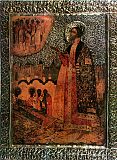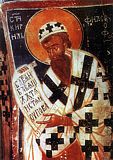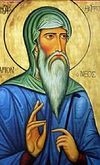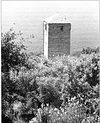

| Previous day | Next day |
| Old Style
February 14
|
Monday |
New Style
February 27
|
|
1st Week of Great Lent.
Tone 4.
Great Lent. |
Monastic rule: total abstinence from food.
|
![]() St. Auxentius, monk, of Bithynia (ca. 470).
St. Auxentius, monk, of Bithynia (ca. 470). ![]() St. Cyril, Equal-to-the-Apostles, teacher of the Slavs (869).
St. Cyril, Equal-to-the-Apostles, teacher of the Slavs (869).
St. Maron, hermit of Cyrrhus (ca. 433). St. Abraham, bishop of Charres in Mesopotamia (5th c.). St. Isaac, recluse of the Kiev Caves (ca. 1090). Translation of the relics of Martyrs Prince Michael and his counselor Theodore, of Chernigov (1578). St. Hilarion the Georgian (the New) of Imereti and Mt. Athos (1864).
New Hieromartyr Onesimus (Pylaev), bishop of Tula (1937).
St. Peter, patriarch of Alexandria (380). Hieromartyr Philemon, bishop of Gaza. New Martyr Nicholas of Corinth (1554). New Monk-martyr Damian of Philotheou and Kissavos, at Larissa (1568). New Martyr George the Tailor, of Mytilene, at Constantinople (1693). St. Raphael, bishop of Brooklyn (1915). St. Ephraim of Katounakia (1998).
Repose of Archimandrite Barsanuphius of Valaam and Morocco (1952), Righteous Barbara (Arkhangelskaya) the Recluse, of Ufa (1966).
Thoughts for Each Day of the Year
According to the Daily Church Readings from the Word of God
By St. Theophan the Recluse

Monday (1st Week of Lent).
“Lent has come, O mother of chastity.” What was the time before this day? A time of fornication.[1] The soul fornicated with all that struck its eye as pleasant—both with people and with things: more fully, with sinful passions. Everyone has his passion which he pleases in all he does. It is time to put an end to this. May each of you comprehend your Delilah, who binds you and hands you over to evil enemies, and abandon her. Then you will be given more than Samson: not only shall your hair grow, but so also shall good thoughts; and not only shall your strength return, but so also your strength of will. Your eyes shall also open, your mind shall have sight and it shall see the Lord, yourself, and everything around you in the proper light. This is the favourable time! This is the day of salvation!
[1] “A time of fornication.” Fornication here has a double meaning in Russian, both of fornication and roaming.
Articles
 Sts. Cyril and Methodius |
 Venerable Isaac the Recluse of the Kiev Near CavesSaint Isaac was the first person in northern lands to live as a fool for Christ. |
 St. Raphael Bishop of BrooklynFrom his youth, Saint Raphael’s greatest joy was to serve the Church. |









